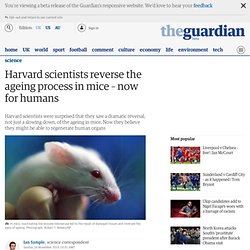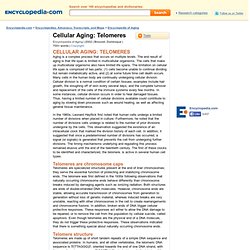

What's the buzz. March 11, 2013, DHNS Life expectancy linked to DNA length Researchers have been able to predict survival rates among patients with heart disease based on the length of strands of DNA found on the ends of chromosomes known as telomeres.

The new study found that the longer the patient’s telomeres, the greater the chance of living a longer life. Previous research has shown that length of telomere can be used as a measure of age, but these expanded findings suggest that they may also predict the life expectancy of patients with heart disease. Telomeres protect the ends of chromosome from becoming damaged.
John Carlquist, PhD, director of the Intermountain Heart Institute Genetics Lab said once telomeres become too short, they no longer function properly, signalling the end of life for the cell and when cells reach this stage, the patient’s risk for age-associated diseases increases dramatically. Quantum computing moves closer to reality Stonehenge was a huge burial ground Go to Top. Harvard scientists reverse the ageing process in mice – now for humans. Scientists claim to be a step closer to reversing the ageing process after rejuvenating worn out organs in elderly mice.

The experimental treatment developed by researchers at the Dana-Farber Cancer Institute, Harvard Medical School, turned weak and feeble old mice into healthy animals by regenerating their aged bodies. The surprise recovery of the animals has raised hopes among scientists that it may be possible to achieve a similar feat in humans – or at least to slow down the ageing process. An anti-ageing therapy could have a dramatic impact on public health by reducing the burden of age-related health problems, such as dementia, stroke and heart disease, and prolonging the quality of life for an increasingly aged population.
"What we saw in these animals was not a slowing down or stabilisation of the ageing process. We saw a dramatic reversal – and that was unexpected," said Ronald DePinho, who led the study, which was published in the journal Nature. Telomerase. Tribolium castaneum telomerase catalytic subunit, TERT, bound to putative RNA template and telomeric DNA The existence of a compensatory mechanism for telomere shortening was first predicted by Soviet biologist Alexey Olovnikov in 1973,[1] who also suggested the telomere hypothesis of aging and the telomere's connections to cancer.

Telomerase was discovered by Carol W. Greider and Elizabeth Blackburn in 1984 in the ciliate Tetrahymena.[2] Together with Jack W. Szostak, Greider and Blackburn were awarded the 2009 Nobel Prize in Physiology or Medicine for their discovery.[3] The role of telomeres and telomerase in cell aging and cancer was established by scientists at biotechnology company Geron with the cloning of the RNA and catalytic components of human telomerase [4] and the development of a PCR- based assay for telomerase activity called the TRAP assay allowing for a survey of telomerase activity in multiple types of cancer.[5] Structure[edit] Function[edit] Clinical implications[edit] Think about lifes end caps. Telomeres: Your Key To Increase Longevity & Quality Of Life.
Cellular Aging: Telomeres – FREE Cellular Aging: Telomeres information. Aging is a complex process that occurs on multiple levels.

The end result of aging is that life span is limited in multicellular organisms. The cells that make up multicellular organisms also have limited life spans. The limitation on cellular life span is comprised of two parts: (1) cells become unable to continue dividing but remain metabolically active, and (2) at some future time cell death occurs. Many cells in the human body are continually undergoing cellular division. Cellular division is a normal condition of certain tissues; examples include hair growth, the sloughing off of skin every several days, and the complete turnover and replacement of the cells of the immune systems every few months.
In the 1960s, Leonard Hayflick first noted that human cells undergo a limited number of divisions when placed in culture. Telomeres are chromosome caps Telomere structure Telomeres are made up of short tandem repeats of a simple DNA sequence and associated proteins. Dominique Broccoli. Orbitally rearranged monatomic elements. ORMES. Telomeres.